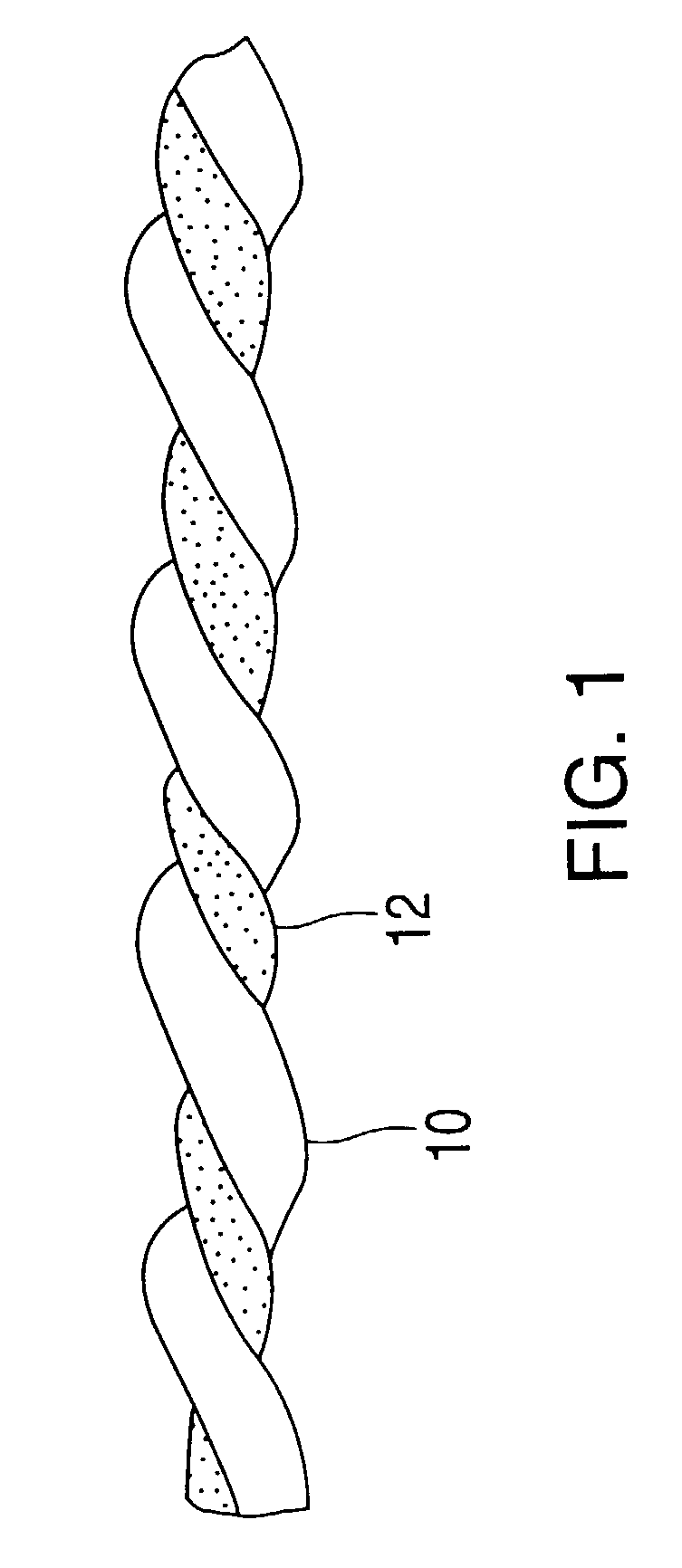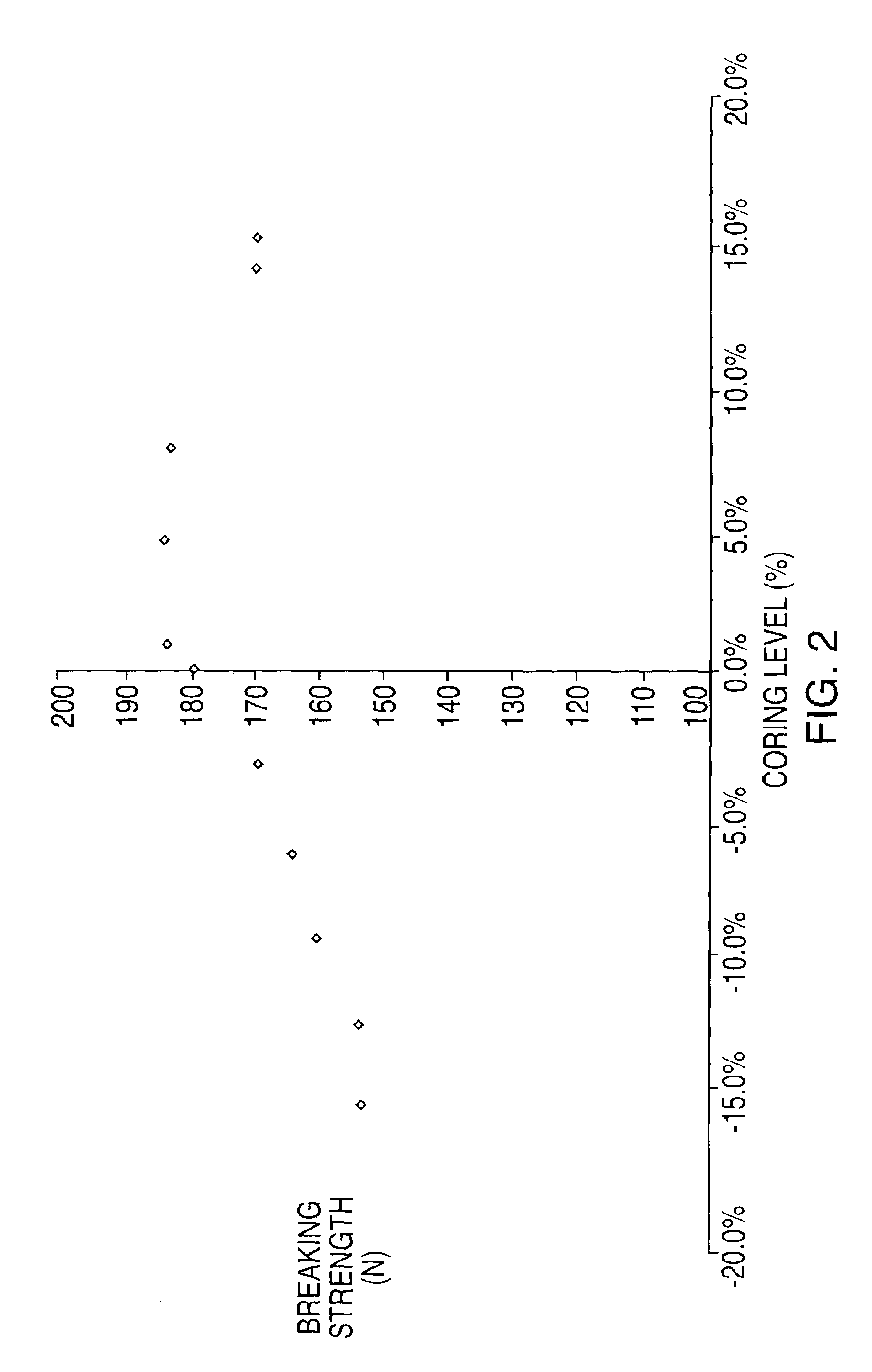Hybrid cabled cord and a method to make it
a cabled cord and hybrid technology, applied in the field of hybrid cabled cords, can solve the problems of poor durability, hygroscopic, low strength, etc., and achieve the effect of improving tensile strength retention and being less expensiv
- Summary
- Abstract
- Description
- Claims
- Application Information
AI Technical Summary
Benefits of technology
Problems solved by technology
Method used
Image
Examples
experiment 1
[0038]The cabled cords in Table 1 were all cabled using a CP560 direct cabling machine commercially available from ICBT. The PEN yarn used in Comp. Exs. A, B and Inv. Exs. 1 through 4 was a 1440 dtex (decitex; 1300 denier) flat yarn having 7.14 denier per filament and is commercially available as PENTEX® yarn from Honeywell. The PET yarn used in Comp. Exs. B, C and Inv. Exs. 1 through 4 was also a 1440 dtex flat yarn having 3.3 denier per filament and is commercially available as DSP® 1×53 yarn from Honeywell. Each cabled cord was twisted at 410 turns per meter (tpm; ˜10.4 turns per inch) and at a spindle speed of 6000 rotation per minute (rpm). The three comparative example cords in Table 1 have a coring level of zero. The four inventive cords have coring levels which are not equal to zero. The non-zero coring in the Inv. Exs. was achieved by adjusting the magnetic bucket pulley.
[0039]The data in Table 1 was measured on greige cord. In Table 1, N is the abbreviation for Newton.
[004...
experiment 2
[0044]To test the effectiveness of the inventive hybrid cabled cords fabric constructions typical of that used to reinforce tires were constructed using a variety of cabled cords. The fabrics had various values for cord ends per decimeter (epdm) as listed in Table 2 and were treated to a dip / dry / stretch / dip / relax process as follows:
[0045]First Dip: Blocked diisocyanate type
[0046]First oven: Drying 45 seconds at 140° C. under 24N / cord tension
[0047]Second oven: stretching for 45 seconds at 238° C. under 24N
[0048]Second dip: Resorcinol Formaldehyde Latex type
[0049]Third oven: drying for 45 seconds at 140° C. under 24N
[0050]Last oven: relaxation for 45 seconds at 238° C. under 12N
[0051]Speed in oven: 26.7 M / minute
[0052]Comp. Ex. D cord was an all-rayon cord in a 1840 dtex×2, 470 tpm construction and had a zero coring level. The remaining cabled cords were those made in Experiment 1. Various properties of these fabrics were measured and the data are summarized in Table 2. “EPDM” stands f...
experiment 3
[0056]To examine the effect of dipping of the hybrid cabled cord on the cord breaking strength and the coring level, greige cord was used to prepare a fabric typical of what is used in the manufacturing of tires. The fabric was then dipped as described in Experiment 2. The coring level and breaking strength were then measured on both the greige cord and the treated cord. The data are reported in Table 3.
[0057]
TABLE 3Greige cordTreated cordCordBreakingBreakingInv.Comp.constituentCoringstrengthCoringstrengthEx.Ex.yarnslevel(N)level(N)APEN / PEN0199.20192.511PEN / PET−13.3%149.9−9.7%140.312PEN / PET −5.8%163.15−4.5%162.0BPEN / PET0180.5 1.5%176.613PEN / PET 3.3%182.0 3.8%182.614PEN / PET 12.4%172.810.8%179.0CPET / PET0177.70182.5
[0058]These data indicate that the dipping process commonly used in the manufacture of fiber-reinforced tires caused very little reduction in the inventive hybrid cabled cord breaking strength and was comparable to the change seen in the all-PEN or all-PET cabled cords. In t...
PUM
| Property | Measurement | Unit |
|---|---|---|
| Fraction | aaaaa | aaaaa |
| Fraction | aaaaa | aaaaa |
| Fraction | aaaaa | aaaaa |
Abstract
Description
Claims
Application Information
 Login to View More
Login to View More - R&D
- Intellectual Property
- Life Sciences
- Materials
- Tech Scout
- Unparalleled Data Quality
- Higher Quality Content
- 60% Fewer Hallucinations
Browse by: Latest US Patents, China's latest patents, Technical Efficacy Thesaurus, Application Domain, Technology Topic, Popular Technical Reports.
© 2025 PatSnap. All rights reserved.Legal|Privacy policy|Modern Slavery Act Transparency Statement|Sitemap|About US| Contact US: help@patsnap.com



